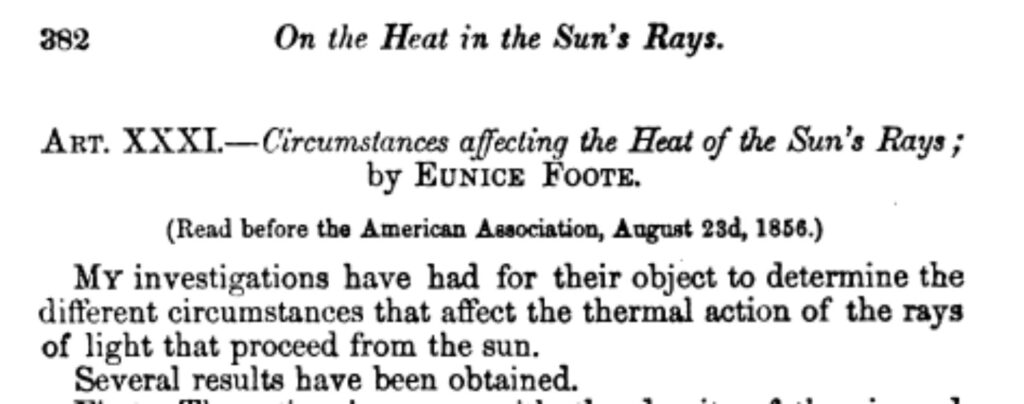
This biography is part of the series Pioneering women in Earth Sciences – the link will take you to the main page.
The cardboard cut-out version of scientists as men with an unruly mop of hair and wearing a grubby white lab coat, is a description that tends to place women on the sidelines, out of earshot and harm’s way. This version of science and its history elevates its heroes and relegates all others to obscure mentions or forgets them altogether.

Eunice Foote’s place in history was a bit like this. In 1856 she published in the American Journal of Science and Arts a brief account of her experiments that investigated the response of different atmospheric gases to incident sunlight. Foote discovered that when the glass tubes contained varying amounts of “carbonic acid gas”, or carbon dioxide were subjected to light, not only did it warm to higher temperatures than other gas compositions, but the high temperatures remained long after the light source was removed. Her conclusion that directly attributed the effect of CO2 to atmospheric warming was prescient – a phenomenon now called the Greenhouse Effect:
“An atmosphere of that gas would give to the earth a high temperature; and if as some suppose, at one period of its history the air had mixed with it a larger proportion than at present, an increased temperature from its own action as well as from increased weight must have necessarily resulted.” (1856, p. 383).
Foote’s paper was read at the August 1856 American Association for the Advancement of Science meeting, not by her but by Joseph Henry (Smithsonian Institution). Henry did however offer praise for Eunice’s ideas that were supported by experiment.
Three years later Irish physicist John Tyndall conducted similar experiments “on the transmission of radiant heat through gaseous bodies.” (Tyndall, Proceedings of the Royal Society of London, May 1959, p.37). Tyndall was so surprised by the results for carbonic acid gas that he published a quick note in the Royal Society Proceedings, and a more detailed account of his experiments in 1861. His experiments were more sophisticated than Footes, but the results were basically the same – the heat absorbed by carbon dioxide atmosphere was greatly in excess of the other gas components, although in his initial note he made no mention of potential atmospheric warming. By this time, Eunice Foote’s work appears to have been forgotten with the inevitable consequence that Tyndall was credited with the discovery. Ortiz and Jackson (2020) have written a good review of Foote’s experiments.
Did Tyndall plagiarise Foote’s discovery? This is a tantalizing question but one where most answers are inconclusive (R. Jackson, 2019). There seems to be no mention of Foote in any of Tyndall’s correspondence, and his 1859 paper states that he is unaware of any previous experimental investigation of this phenomenon. On the other hand, Tyndall was well versed in experimental physics literature of the time. He was also well known for his views that women did not have the intellectual capacity for science. The question remains begging.
In an unfortunate twist of fate, Elizabeth Wagner Reed (1912-1996) who reintroduced us to Eunice Foote’s discovery in 1972 also became the victim of historical forgetfulness. Reed published several papers on genetics (she and her husband were pioneers working on population genetics using the fruit fly Drosophila), the use of pesticides, and was an authority on mental illness. In 1972 she published “American Women in Science Before the Civil War,” highlighting 22 19th-century female scientists, that included a chapter on Eunice Foote. However, Reed too faded into obscurity after her death in 1996 – at least until 2020 when her accomplishments were resurrected by Marta Velasco Martín and subsequently in a New York Times (Overlooked) Obituary by Rachel May (2023).
Foote’s place in history gained increasing attention after Raymond Sorenson published Eunice Foote’s Pioneering Research On CO2 And Climate Warming in an American Association of Petroleum Geology Search and Discovery Article in 2011. Since Sorenson’s paper, there have been many articles describing her life and work, finally cementing her place in the history of science (although many of these are paywalled).
The American Geophysical Union confers annually the Eunice Newton Foote Medal for Earth-Life Science research.
References and other documents
E. Foote 1856. The American journal of science and arts ser.2: v.22(1856) – PDF available Hathi Trust
John Tyndall, 1859. Note on the Transmission of Radiant Heat through Gaseous Bodies. Proceedings of the Royal Society of London, Vol. 10 (1859 – 1860), pp. 37-39 (3 pages). Open Access.
Elizabeth Reed, 1972. American Women in Science Before the Civil War. University of Minnesota, 1992.
Raymond P. Sorenson, 2011. Eunice Foote’s Pioneering Research on CO2 and Climate Warming: Update Search and Discovery. American Association of Petroleum Geologists. PDF available.
R. Jackson, 2019. Eunice Foote, John Tyndall and a question of priority. Notes and Records: The Royal Society Journal of the History of Science. Open Access.
Maura Shapiro, 2022. From Foote-Note to Climate Science Founder: Uncovering Eunice Newton Foote. Ex Libris Universum.
J D Ortiz and R Jackson, 2022 Understanding Eunice Foote’s 1856 experiments: Heat Absorption by Atmospheric Gases. Royal Society. PDF available
Rachel May, April 22, 2023, Overlooked No More: Elizabeth Wagner Reed, Who Resurrected Legacies of Women in Science. New York Times. or an alternative if this is paywalled
Tess Joosse. 2023. August 1856: Eunice Foote Concludes That Carbon Dioxide Could Warm the Atmosphere, Three Years Before John Tyndall Did. This Month in Physics History – American Physical Society.

















